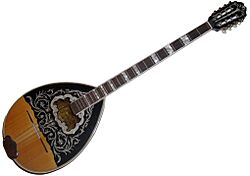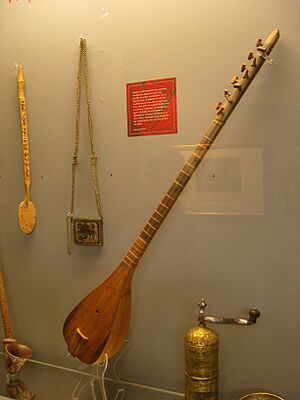Bouzouki facts for kids
 |
|
| Other names | Buzuki, trichordo, tetrachordo |
|---|---|
| Classification |
|
| Hornbostel–Sachs classification | 321.321 (string instrument with a pear-shaped body and a long neck, played with plectrum) |
| Playing range | |
| C3 – E6 (tetrachordo), D3 – E6 (trichordo) | |
| Related instruments | |
|
|
The bouzouki is a popular musical instrument from Greece. It is part of the long-necked lute family. Imagine a guitar, but with a round, pear-shaped body and a very long neck.
It has steel strings and is played with a plectrum, which is like a guitar pick. This gives it a bright, metallic sound, a bit like a mandolin but deeper. The bouzouki is also the ancestor of the Irish bouzouki, which is used in folk music.
There are two main kinds of Greek bouzouki. The trichordo has three pairs of strings. The tetrachordo has four pairs of strings. Greek refugees brought this instrument to Greece in the early 1900s. It quickly became central to rebetiko music. Today, it is a key part of modern Laïko pop Greek music.
Contents
What's in a Name?
The name bouzouki comes from the Turkish word bozuk. This word means "broken" or "modified." It refers to a special way of tuning the instrument.
The bouzouki is related to the mandolin and the lute. When it first arrived in Greece, its body was often carved from a single block of wood. But soon, instrument makers changed it. They added a rounded back, like a Neapolitan mandola. This made the instrument stronger for steel strings.
The older rebetiko music used a three-pair string bouzouki. But in the 1950s, a four-pair string version became popular. A famous musician named Manolis Chiotis helped make it well-known.
How a Bouzouki Is Built

Bouzoukis can look a bit different depending on who makes them. They can vary in neck length, body size, and the width of the wooden strips that form the body. These differences help create different sounds. Some bouzoukis might have a sharper sound, while others sound deeper.
The body's size and shape greatly affect the instrument's sound. The neck's length changes the range of notes the instrument can play. Most bouzoukis have 27 metal frets. These frets are fixed in place on the fingerboard. They help players hit the right notes.
The type of wood used is very important for the sound. For the body, woods like mulberry, apricot, and cherry are best. For the top, or soundboard, cedar or spruce are preferred. The top vibrates and helps make the sound louder and last longer.
Even the varnish matters! The best varnish is natural and applied by hand in many layers. This improves both the sound and the look. The neck needs to be made of very dry, strong wood. This stops it from bending, which would make it harder to play. Many modern bouzoukis have a metal rod inside the neck. This rod makes the neck stronger and can be adjusted if needed.
A Look Back: Bouzouki History

The Greek bouzouki belongs to a family of instruments called the tambouras. This family has been around for a very long time. In ancient Greece, there was an instrument called the pandura. The bouzouki and the baglamas are direct descendants of this ancient instrument. You can even see a muse playing a pandura on an old Greek marble carving from 330–320 BC.
During the Byzantine times, it was first called pandoura and then tambouras. There's even a tambouras on display in a museum that belonged to a hero of the Greek War of Independence in 1821, Yannis Makriyannis.
Other similar instruments exist, like the Greek tzouras, which is smaller than a standard bouzouki.
The bouzouki came to Greece after the 1919–1922 war in Asia Minor. Early bouzoukis usually had three pairs of strings (trichordo). They were tuned in different ways. In the late 1950s, the four-pair string (tetrachordo) bouzouki became popular. Manolis Chiotis made it famous. He also tuned it like a guitar, which made it easier for guitarists to play. This made some traditional players upset, but it helped the bouzouki become even more popular. Recently, the three-pair bouzouki has become popular again.
The Irish bouzouki is a newer instrument. It has four pairs of strings and a flatter back. It was introduced to Irish music around 1965 by Johnny Moynihan.
Three-Course Bouzouki (Trichordo)
This is the classic bouzouki style, popular around 1900. It was the main instrument for most rebetiko music. It has fixed frets and six strings arranged in three pairs.
In the lowest-pitched pair, one string is thick and the other is thin. They are tuned an octave apart. The usual modern tuning for the trichordo bouzouki is D3D4–A3A3–D4D4. This tuning was called the "European tuning" by Markos Vamvakaris.
The bouzouki shown here is a copy of one made for Markos Vamvakaris. It doesn't have a lot of fancy decoration, which was typical for bouzoukis of that time. It has tuners for eight strings, but only six strings are used. This is because the neck is too narrow for eight. Instrument makers often used eight-string tuners because they were easier to find.
Four-Course Bouzouki (Tetrachordo)
This bouzouki has eight metal strings, arranged in four pairs. They are usually tuned C3C4–F3F4–A3A3–D4D4. This is similar to the four highest strings of a guitar.
In the two higher-pitched pairs, both strings are tuned to the same note. In the two lower-pitched pairs, one string is thick and the other is thin. They are tuned an octave apart. On the bouzouki, the lower-pitched string comes first in these pairs. These "octave strings" make the sound fuller. They are used for chords and continuous low notes.
The guitar-like tuning was introduced by Manolis Hiotis. He found it better for his amazing playing style. Today, the tetrachordo is the most common bouzouki in Greek music. However, some traditional players still prefer the trichordo, especially for the older rebetiko style.
Making It Louder: Amplification
Manolis Hiotis not only helped develop the modern tetrachordo bouzouki, but he also started using amplification for it. He might have used it as early as 1945.
The first clear proof of bouzouki amplification is a photo from 1952. It shows musicians using electric guitar-style pickups attached to their bouzoukis. By 1960, special bouzouki pickups were being made. These were permanently installed in the instruments. Today, many Greek artists use similar pickups.
Instruments Like the Bouzouki
The Greek baglamas is tuned like the trichordo bouzouki. But it is pitched an octave higher. It often plays along with the bouzouki in rebetiko music.
Other related instruments include:
Famous Bouzouki Players
- Angelo Avramakis
- Manolis Chiotis
- Anestis Delias
- Alec Finn
- Dimitris Gogos
- Apostolos Kaldaras
- Charis Lemonopoulos
- Colin Meloy
- Giannis Papaioannou
- Spyros Peristeris
- Giannis Tatasopoulos
- Vangelis Trigas
- Babis Tsertos
- Vassilis Tsitsanis
- Markos Vamvakaris
- Nikos Vrachnas
- Giorgos Zambetas
- Phil X
- Frank Zappa
- Roy Williamson
- Mihalis Genitsaris
See Also
- Celtic music
- Cittern
- Greek folk music
- Greek music
- Irish folk music
- Laiko
- Laouto, another Greek lute
- Lute
- Mandola
- Mandolin
- Octave mandolin
- Rebetiko
- Stringed instrument tunings
- Tzouras




